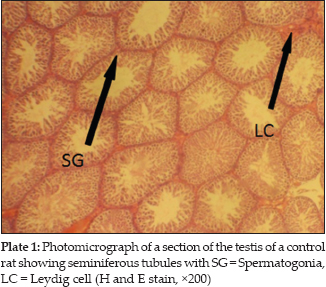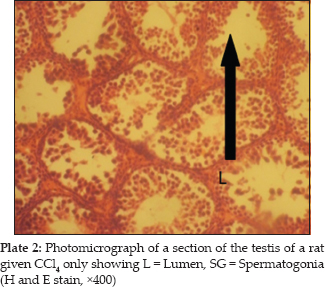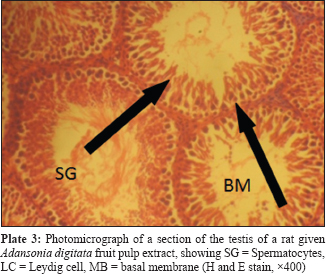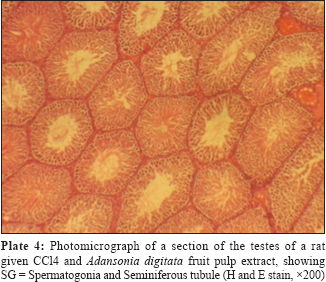|
 
 |
| ORIGINAL ARTICLE |
|
| Year : 2016 | Volume
: 4
| Issue : 2 | Page : 65-70 |
|
Regenerative effects of aqueous extract of Adansonia digitata fruit pulp on carbon tetrachloride (CCl4)-induced oxidative damages in testes of male Wistar rats
Oyetunji Adeoye Oyewopo1, Ade Steven Alabi1, Aminu Imam1, Gabriel Godson Akunna2
1 Department of Anatomy, College of Health Science, University of Ilorin, Ilorin, Nigeria
2 Department of Anatomy, Federal University, Ndufu-Alike Ikwo, Ebonyi, Nigeria
| Date of Web Publication | 18-Apr-2017 |
Correspondence Address:
Oyetunji Adeoye Oyewopo
Department of Anatomy, College of Health Science University of Ilorin, Ilorin
Nigeria
 Source of Support: None, Conflict of Interest: None  | Check |
DOI: 10.4103/2315-7992.204684

Introduction: Adansonia digitata (AD) is a multipurpose tree species widely used for food and non-food products and medicine. Every part of the baobab tree is reported to be useful. However, exposure to high concentrations of carbon tetrachloride (CCl4) (including vapor) had been reported to be injurious to human health. Aim: The present study investigated the effects of AD fruit pulp extracts on CCl4-induced testicular toxicity. Materials and Method: Twenty (20) adult male albino Wistar rats were randomly divided into four groups (A, B, C, and D) with five rats in each group. Group A received distilled water, group B received a single oral dose of CCl4(2.5 mL/kg) for two days, group C received 500 mg/kg body weight aqueous extract of Adansonia, and group D received 2.5 mL/kg of CCl4for two days followed by 500 mg/kg body weight Adansonia aqueous extracts for 14 days. The animals were autopsied 3 weeks after CCl4and AD extracts injection. Results: Result showed that CCl4induced oxidative damage in testes and decreased the hormonal level of testosterone (TT). AD extracts normalized the testicular damages caused by CCl4. Pretreatment with AD ameliorated the testicular content of superoxide dismutase (SOD) activities. Similarly, AD treatment attenuated the CCl4-induced increase in hormonal level. In conclusion, AD ameliorated and protected the testes against CCl4-induced oxidative damages and deranged sperm characteristics in adult Wistar rats. Keywords: Adansonia digitata, carbon tetrachloride (CCl4), oxidative damage, testes
How to cite this article:
Oyewopo OA, Alabi AS, Imam A, Akunna GG. Regenerative effects of aqueous extract of Adansonia digitata fruit pulp on carbon tetrachloride (CCl4)-induced oxidative damages in testes of male Wistar rats. Ann Bioanthropol 2016;4:65-70 |
How to cite this URL:
Oyewopo OA, Alabi AS, Imam A, Akunna GG. Regenerative effects of aqueous extract of Adansonia digitata fruit pulp on carbon tetrachloride (CCl4)-induced oxidative damages in testes of male Wistar rats. Ann Bioanthropol [serial online] 2016 [cited 2017 Apr 26];4:65-70. Available from: http://www.bioanthrojournal.org/text.asp?2016/4/2/65/204684 |
| Introduction | |  |
Exposure to high concentrations of carbon tetrachloride (CCl4) had been widely documented to affect the central nervous system, degenerate the liver and kidney and it has been implicated in the pathogenesis of cancer in laboratory animals.[1] Despite its documented deteriorative effects, it is an extensively used organic chemical in the manufacture of paints, plastics, and chlorofluorocarbon.[2]
The United States Environmental Protection Agency (EPA) has set a maximum allowable level of 0.005 mg/L for CCl4 in public water supplies, as there are no reported short-term or immediate illness symptoms due to exposure at these levels.
The use of phytomedical products in the treatment of diseases is on the rise especially with the recognition and importance of tradomedical health system in many developing nations such as Nigeria.[3] Historically, plants have provided a source of inspiration for novel drug compounds, as plant-derived medicines have made large contribution to human health and well-being. Their roles are twofolds in the development of new drugs; they may become the base for the development of medicines, a natural blueprint for the development of new drugs and a phyto-medicine to be used for the treatment of diseases.
It is of interest therefore to further investigate the effects of a commonly used plant such as Adansonia digitata (AD) on testes whose integrity is necessary to improve spermatogenesis and sperm motility. The African baobab (AD L.) is one of the eight species of baobab (Adansonia) and the only baobab species native to mainland Africa. Like other baobabs, it is a massive deciduous fruit tree, up to 20–30-m high, with a life-span of several hundred years. Its swollen and often hollow trunk looks like a huge bottle and it can be as broad as 3–7 m in diameter. It bears short, stout, and tortuous branches and has a fairly thin canopy. Baobab is strongly anchored in the soil thanks to an extensive, strong root system that grows 2-m deep and whose diameter may be higher than the tree height. The leaves may be simple or digitally compound, dark-green on top, borne at the end of a 16-cm long petiole. The leaflets are 5–15 cm long and 1.5–7 cm broad. Baobab tree shed its leaves during 6 months at the beginning of the dry season and new leaves appear after flowering. The pentamerous flowers are white, large (20 cm in diameter and 25 cm long), and hang from stalks on up to 90-cm long pedicels. The fruit is a voluminous (35-cm long and 17-cm in diameter) ovoid capsule with a hard woody envelope containing pulp and black seeds. Once ripe, the fruit envelope becomes brittle and the pulp has chalky consistency. The tree starts producing fruits 8–10 years after plantation but consequent production only occur after 30 years.[4],[5]
Leaves, bark, and fruits of AD tree are traditionally employed in several African regions as foodstuffs and for medicinal purposes, and for that reason baobab is also named “the small pharmacy” or “chemist tree.”[6] The native African populations commonly use the baobab fruit as famine food to prepare decoctions, sauces, and natural refreshing drink, due to its nutritional properties.[7] The pulp is therapeutically employed as febrifuge, analgesic, anti-diarrhea, and anti-dysentery and for the treatment of smallpox and measles.[6]
| Materials and Methods | |  |
Chemicals
CCl4 was obtained from Denis and Denis Pharmacy, Taiwo Road Ilorin, Kwara State, Nigeria, in the month of March (2013).
Plants materials and its extraction
Fresh pods of AD was obtained from the Biological garden of the University of Ilorin, Ilorin, Kwara State, Nigeria. The fruit pulps were extracted from the seeds using hot distilled water and followed by filtration using filter paper. The combined filtrate was freeze-dried for 72 h to give a shining buff scale.
Preparation of extract
Fresh pods of AD leaves were washed, air-dried, and grounded into a powdery form. The powdery form was then be subjected to aqueous extraction by dissolving 4.0 g in 40 mL distilled water at room temperature and allowed to stand for 20 min to settle. The clear supernatant was carefully separated from the residue which was dried by heating on a hot plate. The dried residue was weighed and the value was used to calculate the concentration.
The general formula stated below was used to obtain the actual volume of the drug to be administered:

The remaining extract was stored in a refrigerator at a temperature of –4°C.
Administration of extract
The extract was administered between 8.00 am and 12.00 pm every day. The rats in group A were in the control group that were fed with rat pellets and distilled water only, while groups B–D served as the experimental groups.
Animals and interventions
The animals and their care were conducted in conformity with international, national, and institutional guidelines for the care of laboratory in biomedical research and use of laboratory Animal in biomedical Research as promulgated by the Canadian Council of Animal care.[8] Further, the animal experimental models used conformed to the guildline principle for research involving the animals as recommended by the Declaration of Helsinki and the guiding principle in the care and use of animals.[9]
The rats were procured from the breeding stock maintained in the animal holding of the University of Ilorin, College of Health Sciences. The animals were housed in well-ventilated wire–wooden cages in the Animal House of the Department of Anatomy, College of Health Sciences, University of Ilorin, Ilorin, Kwara state. The rats were maintained under standard natural photoperiodic condition of 12 h of light alternating with 12 h of darkness (i.e. L:D; 12:12) with room temperature between 25°C and 26°C and humidity of 65 ± 5%. They were allowed unrestricted access to water and rat chow.
They were allowed to acclimatize for 14 days before the commencement of the experiments. The weights of the animals were estimated at procurement, during acclimatization, at commencement of the experiments, and twice within the week throughout the duration of the experiment, using mettler analytical and precision balance (BA 210S, d = 0.0001 g). Satorious GA, Goettingen, Germany.
Twenty (20) adult male albino Wistar rats were used and randomly divided into four groups (A–D) with five rats in each group. Group A received distilled water, group B received a single oral dose of CCl4 (2.5 mL/kg body weight) for two days, group C received 500 mg/kg body weight aqueous extract of Adansonia, and group D received 2.5 mL/kg body weight of CCl4 for two days followed by 500 mg/kg body weightof Adansonia aqueous extracts for 14 days.
Animals sacrificed and sample collection
At the time of sacrifice, the rats were first weighed and then anesthetized by placing them in a closed jar containing cotton wool sucked with chloroform anesthesia for 3–5 min. The abdominal cavity was opened up through a midline abdominal incision to expose the reproductive organs. The testes were excised and trimmed of all fats. The testes weights of each animal were evaluated. The testes were weighed with an electronic analytical and precision balance. Two testes of each rat were measured and the average value was obtained. The testes of each rat were carefully exposed and removed. They were trimmed free of the epididymis and adjoining tissue.
Histological studies
The left testes from each group were fixed in 10% formal saline for 48 h. The organs were dehydrated in ascending grades of alcohol, cleared in xylene, embedded in paraffin, and sectioned. Testicular tissue sections were stained in hematoxylin and examined at a magnification of ×400 under a light microscope.
Assay of oxidative stress marker
The assay of superoxide dismutase activity (SOD). The principle of this assay was to determine the oxidative stress of rats administered with CCl4 and AD. Testicular tissues were transferred into 5 mL ice-cold sucrose solution (0.25 M) and were homogenized. The homogenates were further centrifuged at 3,000 rpm for 15 min to obtain the supernatant, which was then aspirated with Pasteur pipette into a sample bottle, stored overnight at 4°C before being used for assays.
Assay of hormonal activity
The principle of this assay was to determine the hormonal level of rats treated with CCl4 and AD extracts.
Serum levels of testosterone (TT), luteinizing hormone (LH), and follicle-stimulating hormone (FSH) were estimated using the enzyme-linked immunosorbent assay (ELISA) kits from Fortress Diagnostics, Northern Ireland.
Statistical analysis
The Data were analyzed with statistical package for social sciences software by Microsoft excel software using version 16.0. Results were expressed as means ± standard deviation and subjected to statistical analysis using one-way analysis of variance (ANOVA). The significant level considered was P< 0.05.
Testes histology
The seminiferous tubules of control rats were fairly circular or oval in outline with normal seminiferous epithelium and numerous spermatozoa within their lumen and intact interstitium [Plate 1]. The histological profiles of the testes of animals that had only CCL4 showed evidences of degenerative changes in seminiferous epithelium vacuolization of the interstitium and hypospermatozoa formation [Plate 2]. The sections from group C and D rats were largely similar to those of the control rats, with a largely preserved semiferous epithelium [Plate 3] and [Plate 4].



| Results | |  |
Results of phytochemical screening of aqueous extracts of baobab fruit pulp
Phytochemical analysis of aqueous extracts of baobab fruit pulp showed the presence of a compound: Reducing sugars, pectins, protein, fat, crude fiber, ash, ascorbic acid, iron, phosphorus, and calcium.
Body weight changes
[Table 1] shows that the weights of the rats in the control group are significantly different from that of the rats in the AD groups (P > 0.05). The decrease in body weight of the rats in group A and C where more significant than those in group B. However, the decrease in weight of group B rats were more pronounced when compared to those in group D.
Testicular weight of adult male Wistar rats
[Table 2] shows that the testes of rats in the control group and the groups that received both CCl4 and AD had a significant increase in weight when compared to other groups.
Hormonal analysis
The hormonal analysis showed decreases in TT level in groups B–D when compared with FSH and LH in groups B–D. The normal physiological response to the reduction in primary spermatogenesis was a relative elevation in the blood levels of the gonadotrophin in this present work, the mechanism responsible for the rapid increase in FSH and LH levels and decrease in TT level was due to the damages of Leydig cells [Table 3]. | Table 3: Effects of CCl4 and AD fruit pulp on hormone levels of male Wistar rats
Click here to view |
Testicular oxidative stress
Activities of testicular enzymes–SOD: The administration of AD alone causes increase in testicular SOD activities, whereas CCl4 caused a significant decrease in SOD activity when compared to rats in the control group. CCl4+ AD also caused an increase in testicular SOD activities [Table 4]. | Table 4: Effects of CCl4 and fruit pulp extract on SOD levels of male Wistar rats
Click here to view |
| Discussion | |  |
Several aspects of human life and well-being depend directly or indirectly on plant. Plant materials has been subsequently used by traditionalist as an alternative means of curing ailments prevalent in local communities.
The results of the present study indicate that the administration of CCl4 led to severe destruction of the seminiferous tubule, interstitial cells, and spermatogonia, which was in agreement with the histological effects of herbal tea mixture on the rats' testes that revealed interstitial edema and congestion of blood vessels in the testes.[10] The photomicrograph of sections of testes of the rats in group C, that were given AD fruit pulp, only showed normal structures of seminiferous tubules and sperm cells. This shows that AD fruit pulps are likely to improve the function of testes. The photomicrograph of sections of testes of the rats in group D, that were given both CCl4 and AD fruit pulp, showed a recovery after damage from the administration of CCl4, which led to the destruction of seminiferous tubules and degeneration of basal membrane. The effect of CCl4 was likely reversed to some extend by AD fruit pulp. The rats in groups C and D experienced weight gain suggesting that AD fruit pulp has a tendency of causing weight gain.
The hormonal analysis showed decreases in TT level in groups B–D and increase in FSH and LH level when compared with group A (control). The normal physiological response to the reduction in primary spermatogenesis was a relative elevation in the blood levels of the gonadotropins. According to the present work, the mechanism responsible for the rapid increase in FSH and LH levels and decrease in TT level was the damages of the Leydig cells present in the testes.
Lipid peroxidation, GSH content as well as SOD, CAT, GPx and other antioxidant enzymes activities in the biological tissue has always been used as markers for tissue injury and oxidative stress.[11],[12],[13],[14]
In the present study, testiculotoxicity and oxidative damage induced by CCl4 administration were also manifested by a significant decrease in the activity of the SOD. Pretreatment with AD fruit pulp extract markedly modulates the oxidative damages induced by CCl4 administration. The baobab is a multipurpose tree species widely used for food and nonfood products and medicine. Every part of the baobab tree is reported to be useful. AD fruit pulp has been confirmed to have a normalizing effect and it gives a boost of energy. It can overcome a number of health conditions such as liver damage, diarrhea, smallpox, and measles.[15] Exposure to high concentrations of CCl4 (including vapor) can affect the central nervous system and degenerate the liver and kidney.[2]
In conclusion, this present work was designed to investigate the potential regenerative effect of fruit pulp extract of AD as an antioxidant, suggesting that AD fruit pulp has testoprotective effect on CCl4-induced damage on the testes of adult male Wistar rats.
Financial support and sponsorship
Nil.
Conflicts of interest
There are no conflicts of interest.
| References | |  |
| 1. | Rood AS, McGavran PD, Aanenson JW, Till JE. Stochastic estimates of exposure and cancer risk from carbon tetrachloride released to the air from the rocky flats plant. Risk Anal 2001;21:675-95.  |
| 2. | Seifert WF, Bosma A, Brouwer A, Hendriks HF, Roholl PJ, van Leeuwen RE, et al. Vitamin A deficiency potentiates carbon tetrachloride-induced liver fibrosis in rats. Hepatology 1994;19:193-201.  |
| 3. | Akpantah AO, Oremosu AA, Ajala MO, Noronha CC, Okanlawon AO. The effect of crude extract of Garcinia kola seed on the histology and hormonal milieu of male Sprague-Dawley rats' reproductive organs. Nig J Health and Biomed Sci 2003;2:40-6.  |
| 4. | Orwa C, Mutua A, Kindt R, Jamnadass R, Anthony S. Agroforestree Database: A tree reference and selection guide version 4.0. Kenya: World Agroforestry Centre; 2009.  |
| 5. | Jansen PC, Jukema J, Oyen LP, van Lingen TG. Adansonia digitata L. In: Verheij EW, Coronel RE, editors. Record from Proseabase. Bogor, Indonesia: PROSEA (Plant Resources of South-East Asia) Foundation. 1991.  |
| 6. | Etkin NL, Ross PJ. Food as medicine and medicine as food. Soc Sci Med 1982;16:1559-73.  |
| 7. | Lockett CT, Calvert CC, Grivetti LE. Energy and micronutrient composition of dietary and medicinal wild plants consumed during drought. Study of rural Fulani, Northeastern Nigeria. Int J Food Sci Nutr 2000;51:195-208.  |
| 8. | Canadian Council of Animal Care. Guide to the Handling and Use of Experimental Animals. Ottawa: Ont.; 2 United States NIH Publications; 1985. p. 45-7.  |
| 9. | World Medical Association; American Physiological Society. Guiding principles for research involving animals and human beings. Am J Physiol Regul Integr Comp Physiol 2002;283:R281-3.  |
| 10. | Ratnasooriya WD, Fernando TS. Effect of black tea brew of Camellia sinensis on sexual competence of male rats. J Ethnopharmacol 2008;118:373-7.  |
| 11. | Chularojmontri L, Wattanapitayakul SK, Herunsalee A, Charuchongkolwongse S, Niumsakul S, Srichairat S. Antioxidative and cardioprotective effects of Phyllanthus urinaria L. on doxorubicin-induced cardiotoxicity. Biol Pharm Bull 2005;28:1165-71.  |
| 12. | Prahalathan C, Selvakumar E, Varalakshmi P. Lipoic acid ameliorates adriamycin-induced testicular mitochondriopathy. Reprod Toxicol 2005;20:111-6.  |
| 13. | Ateşşahin A, Karahan I, Türk G, Gür S, Yilmaz S, Ceribaşi AO. Protective role of lycopene on cisplatin-induced changes in sperm characteristics, testicular damage and oxidative stress in rats. Reprod Toxicol 2006;21:42-7.  |
| 14. | Priestman T. Cancer Chemotheraphy in Clinical Practice. London, UK: Springer-Verlag; 2008. p. 130-6.  |
| 15. | Al-Qarawi AA, Al-Damegh MA, El-Mougy SA. Hepatoprotective influence of Adansonia digitata pulp. J Herbs Spices Med Plants 2003;10:1-6.  |
[Table 1], [Table 2], [Table 3], [Table 4]
|